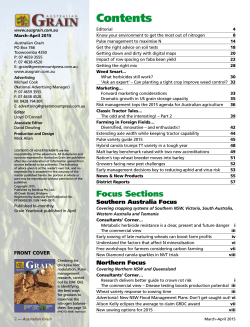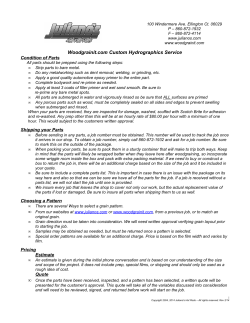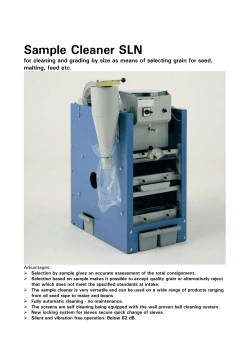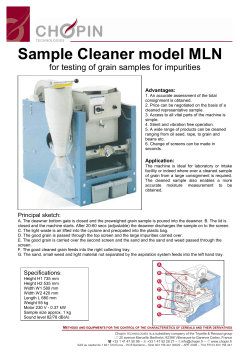
Freedom in Western Grain Movement: Why the
37 CP photo Freedom in Western Grain Movement: Why the Revenue Cap Needs to Go Barry Prentice and Graham Parsons Last winter’s grain transportation crisis focused the nation’s attention on Canada’s grain handling and transportation system in a way that exposed many of its long-standing problems without exploring either their causes or the potential solutions. Barry Prentice and Graham Parsons advise that, first, the revenue cap, which imposes a limit on railway revenue from grain transportation, has to go. Then, they suggest that Canada get rid of the new Fair Rail for Grain Farmers Act. I n the 20th century, Western Canada’s grain handling and transportation system (GHTS) allowed Canada to create an agricultural economic relationship with Europe that was the envy of the world. Advanced steam locomotives crossed the mountains in the West and the Canadian Shield in the East, overcoming terrain and distance, while grain elevators kept grain dry and segregated to meet market and travel requirements. Rail and elevator networks brought new technology to March/April 2015 38 As the 21st century unfolds, agricultural exports continue to play a major role in Canada’s economic growth, and market opportunities are emerging that could dramatically increase grain exports by 2050. The world’s growing population will require food, fertilizer and energy resources from Western Canada, and our dependence on a financially strong railway network will be no less important to our economy in the next 85 years than it was in the 20th century. Whether Canada can move increased amounts of grain through its export supply chain in the years ahead will depend on achieving an internationally competitive price, and reliable and timely delivery for grain from farm gate to port. However, efforts by successive Canadian governments to manage the export movement of grains through the 20th century did not serve western Canadian farmers well. Regulation by the federal government, and its agent the Canadian Wheat Board, of marketing, transportation and storage of grain led to efficiency losses, massive investment deficits and large government subsidies. Remnants of the old commandand-control regulatory framework remain. Specifically, the Maximum Grain Revenue Entitlement Program (revenue cap), first introduced in 2000, is still in force. It creates a ceiling on the total railway revenues that can be earned from moving grain by rail in any crop year, based on volume and length of haul. The revenue cap applies to revenues earned by CN and CP on non-USbound export shipments from Western Canada routed through the West Coast ports of Vancouver and Prince Rupert, and eastern ports of Thunder Bay and Armstrong. A lthough initially viewed as a modern approach that stepped away from the strictly regulated Crow’s Nest regime, and later the Western Grain Transportation Act, Policy Whether Canada can move increased amounts of grain through its export supply chain in the years ahead will depend on achieving an internationally competitive price, and reliable and timely delivery for grain from farm gate to port. the Revenue Cap has now reached a point of diminishing returns for farmers and the broader GHTS. The cap is hurting the efficiency, growth and productivity of the system, by limiting the investments and innovation, technology and capacity required to competitively move Canadian grains and other products to world export markets. on operations, maintenance, and investment in infrastructure, technology and capacity. However, the Revenue Cap does not cover the full costs of moving grain, so other commodity shippers have to make up the difference. The capacity and efficiency of the GHTS have improved significantly over the years, thanks to investments throughout the system. Hopper cars have replaced box cars, trains are now driven by diesel-powered locomotives, and other innovations, such as large grain elevators and bulk ocean carriers have been brought on-line, increasing grain throughput across the system. Figure 1 shows the growing gap between the average rail freight rate for grain and that of all commodities from 2001 to 2013. Over this period, grain revenues per tonne-kilometre increased by 14 per cent, less than half the rate of increase for all commodities. Grain rates have also not kept pace with inflation, as measured by the Consumer Price Index. Grain railway regulation creates a cumulative revenue deficit for rail investment and GHTS efficiency in Western Canada. All commodity shippers share the benefits of the railways spending Although Canada’s two Class 1 railways make large annual capital in- Average Freight Rate vs. Regulated Grain Rate Canadian Class 1s - Canadian Operations FIGURE 1: Average Freight Rate vs. Regulated Grain Rate. Canadian Class 1s – Canadian Operations 3.5 Cents per Revenue Tonne-Kilometres thousands of Prairie communities, and the region thrived. 3 2.5 2 1.5 1 2001 2002 2003 2004 2005 2006 2007 2008 2009 2010 2011 2012 2013 Regulated Grain Revenue per RTK Canadian Class 1 Average Revenue per RTK Source: Railway Association of Canada 39 vestments in efficiency, capacity and productivity—in 2013, they invested some $1.8 billion back into their networks—the Revenue Cap removes the incentive for railways to invest and introduce innovation that can provide efficiency gains throughout the GHTS. For example, the GHTS needs investment to address the aging fleet of government-owned hopper cars. Between 1972 and 1994, the federal and Prairie provincial governments and the Canadian Wheat Board purchased some 16,500 hopper cars, with a capacity to carry 4.3 million tonnes of grain. However, the number of serviceable cars is falling year after year—dropping 38 per cent over the last decade alone, to around 8,366 cars. If this fleet is not replaced quickly, the capacity of the GHTS to move grain will be dramatically reduced. Under the current regulatory regime, railways are effectively prevented from replacing government-owned hopper cars with modern ones. New hopper cars would immediately increase the capacity and efficiency of grain movements throughout the GHTS. New hopper cars are shorter, can carry more grain, and allow for additional cars to be carried by a unit train. But with a price tag ranging from $75,000 to $95,000 per new car, the cost of replacing the fleet is estimated between $630 million and $800 million. Under the current regulatory regime, railways are effectively prevented from replacing government-owned hopper cars with modern ones. New hopper cars would immediately increase the capacity and efficiency of grain movements throughout the GHTS. Freeing western grain movements from the arcane regulatory approach of the past is essential to Canada’s international competitiveness. The Revenue Cap— first introduced as a temporary measure 15 years ago—lies at the heart of the failures of Canada’s grain handling and transportation system, and stands as a threat to its continued health. T he Revenue Cap also creates a disincentive for railways to move grain in containers. Containerization provides a means of segregating and shipping exact quality specifications to buyers, which the market rewards, and is of particular value to farmers of specialty crops. The large inventory of empty backhaul containers moving through Western Canada en route to Asia could provide important additional capacity to address the periodic surges and super surges in grain export demand. However, the railways’ costs are higher for container movements, so the rates charged to load grain into containers on the Prairies must be higher too. The extra revenue earned from moving containerized grain shipments also eats up the Revenue Cap more quickly. Ultimately, this forces the increasing number of shippers who want to move their grain in containers to ship their product to the ports by other means, where it can be transloaded into containers. T he regulation of grain transportation in Canada is unique. Unlike all other commodities transported by rail through commercial arrangements that reflect market-based principles, the federal government has intervened continuously and, too often unsuccessfully, in the transportation of grain by rail. The latest intervention is the Fair Rail for Grain Farmers Act and its associated regulations, which stipulate minimum volumes of grain that must be moved during the peak shipping season by Canada’s two Class 1 railways. These regulations, combined with the Revenue Cap, mean that the government now regulates price and quantity while also owning an aging and diminishing fleet of hopper cars. Freeing western grain movements from the arcane regulatory approach of the past is essential to Canada’s international competitiveness. The Revenue Cap—first introduced as a temporary measure 15 years ago—lies at the heart of the failures of Canada’s grain handling and transportation system, and stands as a threat to its continued health. First, western Canadian farmers have lost market share and incomes because the GHTS is inefficient. Second, delays in investment to modernize the GHTS or to introduce innovation mean that inefficiencies will continue to persist, and farmer incomes will be reduced. Third, to the degree that grain transportation does not pay its full costs, other commodity shippers must. Therefore, the Revenue Cap acts like an export tax on all non-agricultural products. Free markets work to create system efficiencies. In the end, Western Canadian farmers have more to gain from recovering their share of a growing world grain market than from whatever perceived protection Canada’s current regulatory system has to offer. Barry Prentice is Professor of Supply Chain Management at the University of Manitoba’s Asper School of Business. barry_prentice@umanitoba.ca Graham Parsons is President of the Organisation for Western Economic Cooperation. owecgfp@accesscomm.ca March/April 2015
© Copyright 2025









